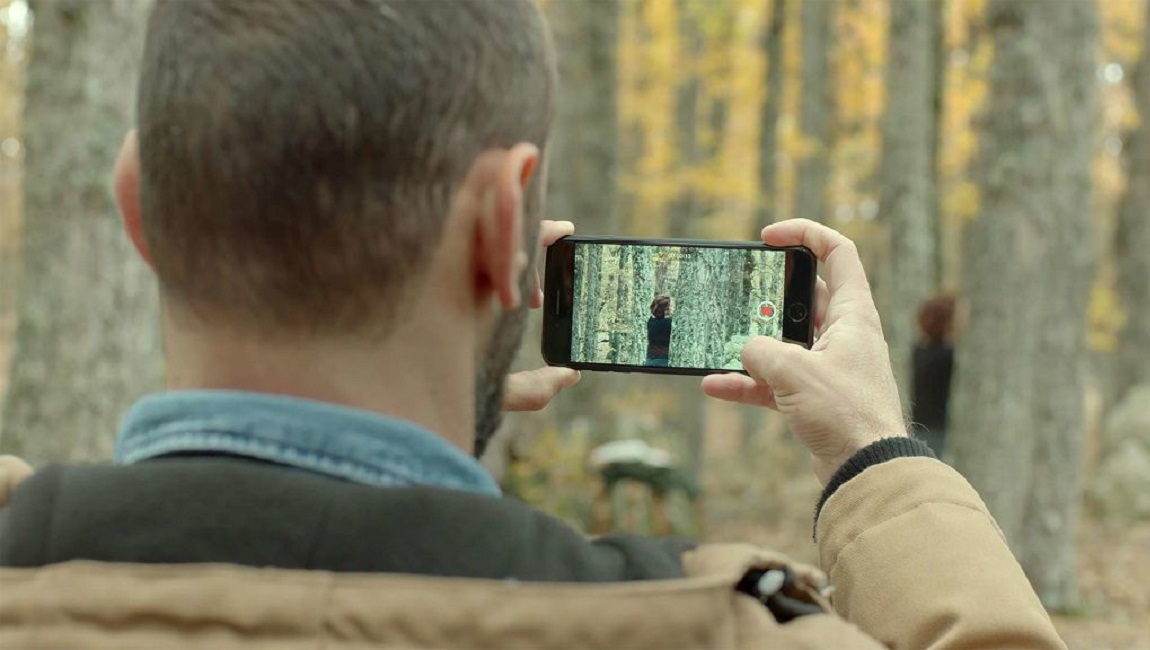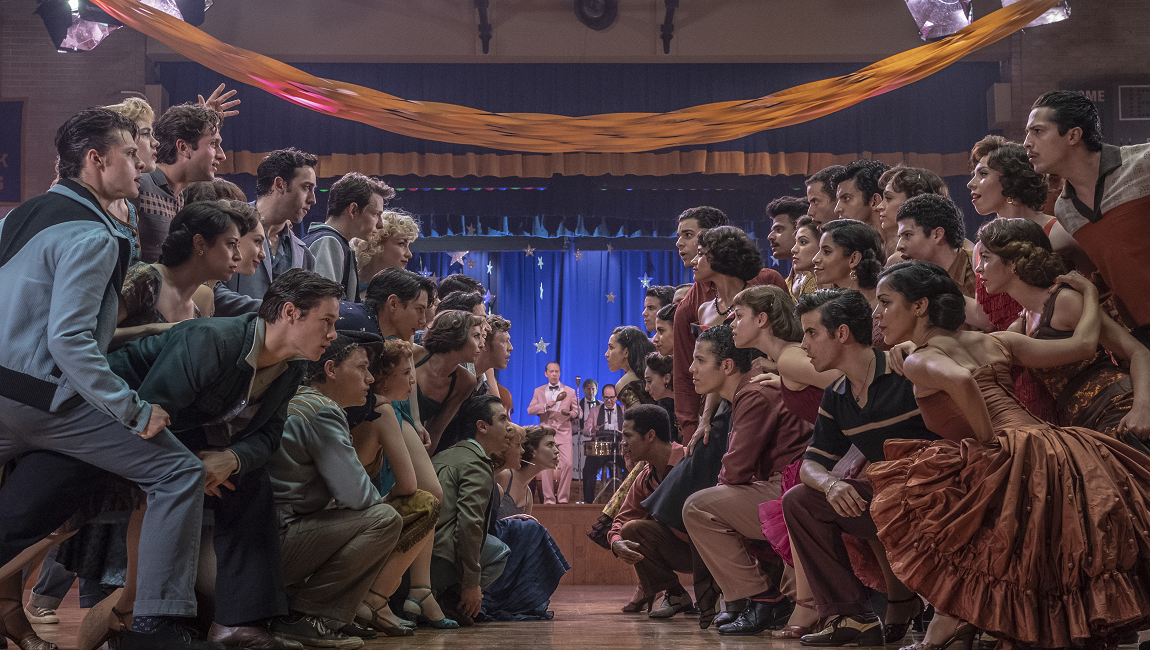Heaven Reaches Down to Earth
Tebogo Malebogo’s Heaven Reaches Down to Earth begins with red embers dancing. Their subtle flickers, alongside the pulsing buzz of insects, lead into the sounds of two men’s footsteps. They belong to Tumelo (Thapelo Maropefela) and Tau (Sizo Mahlangu), and Malebogo establishes a poetic dialogue between these two Black men and the nature they’re surrounded by. Here, across the mountainous fields of South Africa’s Limietberg Nature Reserve, he utilizes a wide aspect ratio and wide-angle shots to depict the vast expanse of the terrain, but also of Tumelo and Tau themselves: despite how small they may be in the middle of this huge space, they feel grand. The voice-over makes this clear: “I approach the fire, my duty is to put it out. We men refused.” These lines refer to their denial of tradition in order to embrace their sexuality: along with traversing craggy land, the two swim together and run their hands across skin. There’s an ever-present sense of tension, though, strewn across their faces, and, even more impactfully, embedded in the Heaven Reaches Down to Earth’s quietude. But most crucial is the film’s aesthetic structuring: the more intimate passages employ a 4:3 aspect ratio and don’t initially contain voice-over, creating a clear delineation between those and the more lyrical wide-shot compositions. Narration eventually does appear, however, to bridge the personal and universal. This collapsing of ideas informs the film’s linear spiritual journey, which culminates when the two climb a mountain and the voiceover proclaims: “We climbed to where heaven reaches down to earth. We find nothing. The fire isn’t meant to be put out.” The truth we seek, Malebogo seems to suggest, isn’t one that’s obscured or needing to be sought; it’s often right here, around us and in us.

Credit: IFFR
Surviving You, Always
Much like James Benning’s American Dreams (Lost and Found), Morgan Quaintance’s Surviving You, Always juxtaposes two narratives in a manner that feels impossible to take in all at once. Here, voice-over comes from Timothy Leary & Ram Dass, countercultural icons from the 1960s who did studies on LSD and wrote at length about their positive effects. They’re contrasted with diaristic text from Quaintance himself, as he recalls the 1990s and a year spent experimenting with the same drug, finding his experience to be much less positive, let alone spiritual. “People attach mystical significance to the drug,” he explains. “For us it was a cheap way to get smashed, and emotionally it wrung us all out.” There’s an obvious contrast here that’s being established between Leary and Dass — white professors at Harvard — and the director’s own working-class life in South London as a Black man. “It made us paranoid, detached and anxious,” he continues. We see black-and-white photographs onscreen, but they’re generally static, allowing for scene-setting, yes, but more importantly, a concentrated look at the differences between these two experiences. In a sense, Leary and Dass feel overpowering — sound does indeed feel more active and lively than any bit of text appearing onscreen — and this decision seems pointed: according to an interview, Quaintance had been thinking about these memories for much of his life, and presenting them in a modest manner adds to how they or other similarly bleak stories haven’t really been told, at least in the context of art.
There are moments of repose wherein Quaintance removes us from the static image of a photograph. He shows multiple in succession — or via a filmed sequence — and they’re soundtracked, in part by a Schubert piano sonata. The general feeling is that of listlessness, of moving through life in a perpetually bleary state. Such sadness is compounded by a memory he shares of a best friend and love interest who went to jail. When Quaintance and this woman reconnected, he recounts that he had realized only then that their relationship was over. It was from this woman that he learned about Saccharine Trust, the raucous punk band whose debut LP is the inspiration for this film’s name. Fittingly, Surviving You, Always ends with the band’s “A Human Certainty,” a song that proclaims: “I wanted to touch you. I wanted / to feel you. I wanted things to be / just like they used to be except I’d / keep all my promises and then I felt / so ashamed. / I was so ashamed until / I realized we’re all guilty of that dream.” These words tie everything together, a reminder that within these fragmented memories we all hold are portals into past and different selves. “I learned nothing about myself or others,” Quaintance says about LSD. It’s in his fractured recollections — blurry, surreal, disorienting — that he’s instead able to do so.
Limousine
Few vehicles are as unique as the limousine. If one were to think about it in terms of its utility — specifically as the liminal space between the start of an ordinary evening and one’s entrance into a party or celebration or wedding — then one can see it as a social lubricant, as the site and embodiment of pre-gaming, as a host of excitement and anticipation and anxiety. Saule Bliuvaite’s Limousine, shot entirely inside the small interior space of the eponymous vehicle, is, as expected, adorned with colorful lights, soundtracked with upbeat pop music, and finds people clinking glasses as they drink. We witness a slew of people both young and old, male and female, and the camera rarely lingers on a scene for long, allowing the viewer to see the social dynamics between each group — how much they differ and how much they’re ultimately the same. One group of riders, for example, is presumably deaf, and signing with each other to communicate. They talk about alcohol, and are having as enjoyable a time as the children who are too young to drink but nevertheless dancing to the music, or the older women who are holding their wine glasses and singing together. Amidst these shots of different groups, there are brief moments of drama, of excitement for the night ahead, of exhaustion from the night that’s passed. Whatever the case, we never get full details, just glimpses into the lives of each occupant. We see this in relation to the limousine’s ultimate purpose and influence, understanding that it in all its kitschy glamor, the limo forces one to ride a wave of excitement — it feels as if there are only a limited, specific set of moods allowed here. This becomes most clear when, near the end of the film, we see a woman crying. It’s a moment that feels profoundly out of place, so much so that Bliuvaite’s decision to largely obscure her face seems fitting. No other vehicle feels so demanding and controlling of our emotional responses.

Credit: Film at Lincoln Center
Summits and Ashes
Fernando Criollo’s Summits and Ashes is a largely black-and-white ethnographic documentary shot in the Peruvian mountains. It begins memorably, with a shot of billowing smoke and birds flying overhead. As thunderous explosions are heard, it’s soon obvious that Criollo is rarely aiming to have the sound completely match his images — a decision that greatly amplifies the emotional and spiritual atmospheres of the ceremonies onscreen. Early on in the film, Criollo utilizes metallic ambience, recordings of celebratory brass and cymbals, and the aforementioned explosions to score a slow-motion shot. We see dozens of men aligned in rows while carrying a statue, and as all sound dissipates, the silence bolsters the grandiosity of the image. Criollo’s rationale for forgoing color is obvious: the grayscale images make everything feel interconnected, bleeding into each other — the people and the land, the mountains and the sky, the light and the dark. When we see pieces of white hail falling onto a dark patch of land, it feels no different than watching a group of people sing and wave flags on a street: we’re all but small beings in the grand scheme of things. Meanwhile, the woozy editing of music here is an invitation to appreciate these images and sound as something beyond mere textural elements; we’re asked to displace ourselves, to check our ego. And even though the intent of these ceremonies isn’t ever explained, there’s an understanding of togetherness and community and the existence of something beyond our limited selves. When a reverb-drenched voice declares statements to the “Holy Father,” Criollo ends with a beautiful image of mountains and clouds, tinted with a golden yellow. It’s a recalibration; a visual and aural depiction of pre- and post-ceremony. In the aftermath, everything is sacrosanct.
Hola, Abuelo
Manuela Eguía’s Hola, Abuelo is short and inconsequential enough to be interesting. The details are simple: it’s 139 seconds long and features pencil drawings depicting the day in the life of the director, described as “a foreigner in Mexico.” None of the images are technically impressive, and the voice-over is rushed, generally lacking in emotion, and poorly recorded — the whole film has the tenor of a quickly-finished school project, not least because it begins with salutations. Everything is ordinary: she wakes up, eats breakfast, sees her dog, goes to work. Sound effects appear as well, and they’re usually amusing — at one point, she talks about going on the subway and a whooshing sound mimicking the vehicle is made by someone’s voice (more than anything, this recalls the video game Hidden Folks). As Eguía describes her job, there’s an amusing contrast between it and the film; she sells drawings, and the rudimentary images that constitute this short feel like a salve from workplace life. This quickly leads into more lively moments found within the office: dancing on Fridays, tasty quesadillas. And just as it feels like it’s going to be impossibly hard to justify this film’s existence, Eguía reveals that she’s currently at work right at this moment, writing and drawing and speaking because this film is a present to her grandfather. “I love you very much,” she says. “Drink water, eat well.” All of a sudden, then, the film’s light frivolity becomes something closer to charming. More than anything, Hola, Abuelo is a reminder that sometimes the smallest homemade things — even just thinking of someone else, and letting them know you are — can be a wonderful gift.

Credit: Film at Lincoln Center
More Happiness
Livia Huang’s More Happiness begins with a question: “Why does a person have to like you more than you like them?” This question, asked by a second-generation Chinese American daughter (Tina WongLu), gets answered by her first-generation mother (Rui Ying Lu), with statements including “Women are like that, more selfish. If a man loves you more, wouldn’t it be more fun?” She then clarifies. “For Chinese people, anyways. You American-born, you’re probably not the same. You want what you like.” The film then proceeds to various flashbacks between WongLu and her ex (Joyce Keokham), with a suggestion that WongLu’s desire for something more equal — something removed from aforementioned power dynamics — can more readily exist in queer relationships. The film continues with dialogue regarding happiness and love, and there’s a tenderness in how Huang depicts these things as manifesting and disappearing. We witness someone rubbing sunblock on another’s back, followed by a shot of beach towels without anyone lying on them. At another point, we see WongLu and Keokham dancing to Bappi Lahiri’s funky disco track “Come Closer,” and a shot of cake with candles. Suddenly, all we see are two balloons in a darkened room. These stark contrasts of intimacy and emptiness — linked together via L-cuts — elicit an uneasy, lingering sadness. Near the end of More Happiness, WongLu puts a parakeet into her tank top, and uses a toilet paper roll to play with it. The parakeet happily stays there, and the two are content — neither leaves the other. It’s an aching moment that muses: if only all relationships were so easy; if only happiness could be so easily attained.







